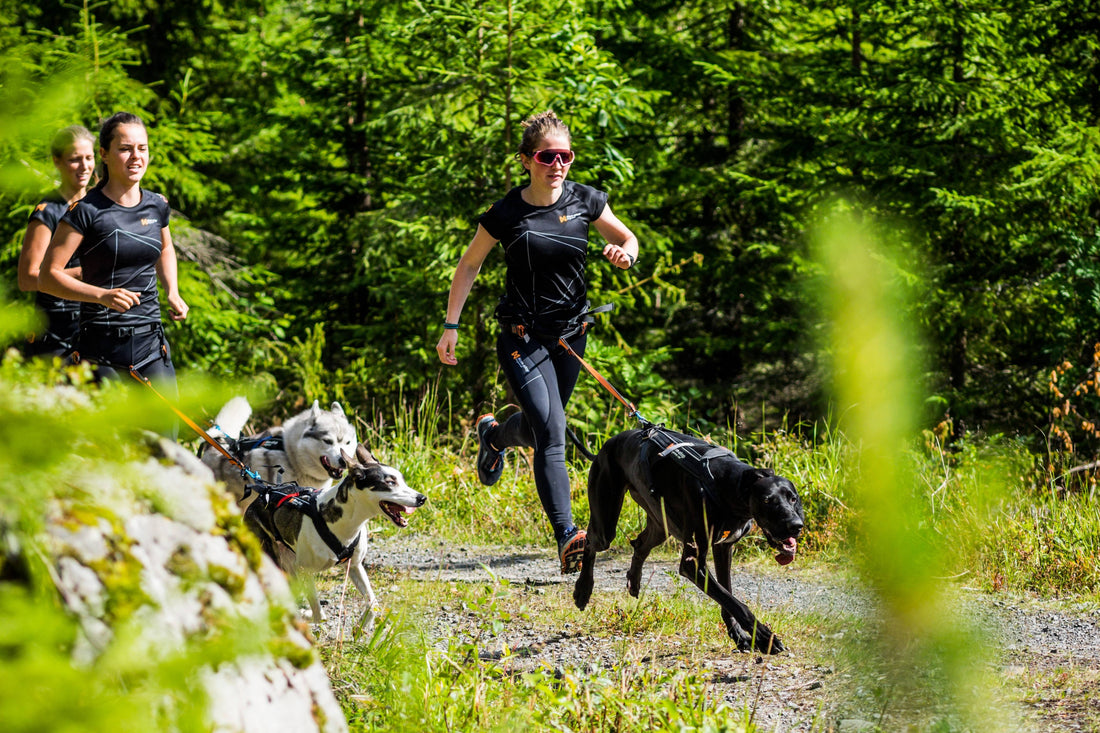
How to train and compete with reactive dogs
Share
Having a reactive dog is a challenge if you want to compete dog sports like canicross, bikejoring, skijoring or dog mushing. Behavior like lunging at other dogs is unacceptable. Luckily, it is possible to train a dog to not be reactive.
What is a reactive dog?
A reactive dog will overreact because of certain triggers. The overreaction can take shape in behaviors like biting, barking or growling. Common triggers are other dogs, people running or wearing something specific or specific situations.
At trainings or races, situations like waiting in the starting area, mass starts or overtaking can trigger reactivity.
- Saying that the dog is nipping at other dogs or people because it is eager to run is no excuse. A dog should not do that at all, says sprint and mid distance musher Tom Andres in our podcast Unleashed.
Long term thinking
If one of Tom’s dogs shows signs of reactivity towards others, he will address the situation immediately.
- That is an investment in the future. You might lose that race, but it’s worth it in the long run. Correcting unwanted behavior immediately will set the standard for many years to come.
If you know that your dog is prone to lunge at passing teams when being overtaken, stop when the other team approaches and stand next to the dog.
- Let the other team pass. If your dog just looks at them, correct him.
How to correct my dog?
Correction should not be mixed up with punishment. You should always treat your dog with respect and not harm him or her.
A correction can simply be guiding your dog to replace the unwanted behavior with what you want, for example looking straight ahead or moving to the opposite side. Correction may also be saying «no».
- When having a reactive dog, skijoring is great, as you can use the ski poles as an extension of your arm, says Lena Boysen Hillestad.
She would use the pole as a barrier towards the other team, and to correct the dog.
- Not hit, but correct. Meaning I gently guide my dog in the desired direction.
If overtaking triggers your dog, train overtaking with others and gradually expose yourselves to bigger challenges. If you do not manage to solve the problem yourself, seek help from others.
Harness for reactive dogs
If you're concerned that your dog might back out of their harness or if you need a handle for positive control in challenging situations, the Rock harness long is the ideal choice.
This multi-use dog harness is designed to aid with pulling, making it suitable for dog-powered sports. It's secure, equipped with a handle, and comfortable for your dog to wear.
Don’t take it personally
There are many reasons why some dogs get reactive. Lack of socialization, bad experiences or even genetics can cause dogs to be reactive. Whatever the reason is, don’t take it personally.
- No one’s perfect. Everyone has dog fights. Everyone has the case where their dog growls at another dog or something. People don’t get along all the time. We have our own issues, and dogs are the exact same way. Don’t let bad things that happens ruin your confidence, because dogs feed off your energy. Everyone else deals with the exact same issues. Don’t take it personally. It doesn’t mean you failed as a dog trainer. It just means you have more work to do, which everyone does, says Nick and Joy Weis in our podcast Unleashed.
When you look at social media everyone’s dogs seem to be perfect, but remember that nobody’s going to post a picture on Instagram of their two dogs that just got in a fight.
- When those fights or those scuffles do happen, what caused it? What was the issue? These incidents gives you a little bit of perspective, too, into how your dog is thinking. Work through those issues and remember; they are animals. They have instincts. Just work through it, says Joy.